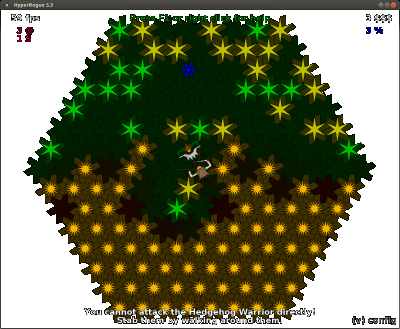So, here are the most significant results:
Crossroads and Great Walls: Infinite straight lines which never cross... Well, this effect cannot be achieved in Euclidean geometry. Unless all great walls are parallel, but this is boring.
General Tactics: In most roguelikes, when two monsters are attacking you, a good strategy is to enter a corridor, so that they have to attack you in a queue. In HyperRogue, this can be done practically everywhere, by using the properties of the hyperbolic geometry. And this does not work on the Euclidean hex board, so if two monsters are attacking you at the same time, you have to run until you either find a third monster (which is usually game over), or you are saved by a terrain obstacle.


Living Caves:Land generation is slightly biased towards wall tiles here. In hyperbolic geometry, you could still go wherever you wanted, but in Euclidean, you will soon find out that walls are blocking all your paths.
Dry Forest: As above, walls block your movement more efficiently than on the hyperbolic plane, and thus, it seems harder to escape fires... (This is the new land in the Steam version.)
Land of Eternal Motion: On the hyperbolic plane, if you escaped by running on a straight line, Running Dogs would not catch you, because they would be forced to go on an equidistant curve, and these are longer than straight lines. On the hex board, it is impossible to escape even from a single Running Dog.
Orb of Yendor: The quest for Orb of Yendor is obviously much easier in the Euclidean world :)
The Euclidean mode is available in the Steam version of HyperRogue (5.3), on the third page of the config menu. It is not yet available in the free version, nor for other platforms, but it will be added later. Have fun!
No comments:
Post a Comment